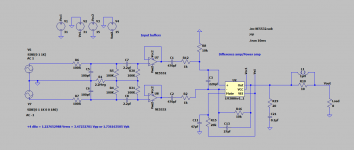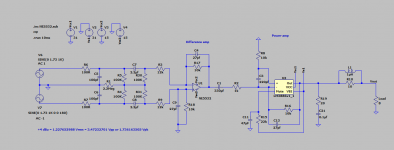Hello everyone!
I have been reading more on the instrumentation amp configuration theory and from what I understand CMRR or common mode rejection ratio is an important measurement to pay attention to when choosingsumming difference amp IC (U3 in the schematics below).
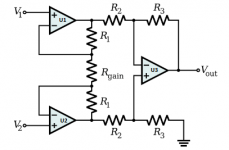
Now, when designing amplifier with differential signal inputs (or balanced inputs) there are a few options. One configuration could be to use LM3886 as U3summing difference amp and to use two LM4562 as an impedance buffers U1 and U2. In such configuration the extent to which circuit is able to reject common mode noise and interference is defined by LM3886's CMRR. The datasheet provides it in Figure 48 on page 16:
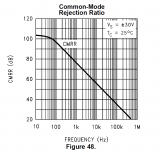
Another configuration can be to use LM4562 as asumming difference amp. It's CMRR is provided in the datasheet on page 18:
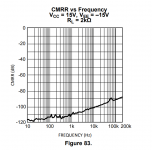
Comparing those two graphs it can easily be seen that LM4562 is better option for thesumming difference amp U3.
With that said, I have a few questions:
Thanks in advance,
Pavlo
I have been reading more on the instrumentation amp configuration theory and from what I understand CMRR or common mode rejection ratio is an important measurement to pay attention to when choosing

Now, when designing amplifier with differential signal inputs (or balanced inputs) there are a few options. One configuration could be to use LM3886 as U3

Another configuration can be to use LM4562 as a

Comparing those two graphs it can easily be seen that LM4562 is better option for the
With that said, I have a few questions:
- If I were to use LM4562 as a
summingdifference amp, how would I feed signal into LM3886? Non-inverting or inverting configuration? - Am I missing anything as far as differential signal extraction?
Thanks in advance,
Pavlo
Last edited:
Example of how LM3886 can be used as a summing amp can be found here in this thread - https://www.diyaudio.com/community/...ed-input-lm3886-design-and-pcb-layout.371161/
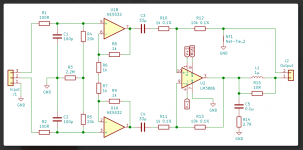

That second circuit with LM3886 is a balanced POWER amplifier, for driving a speaker. The topology is similar,
but the application is different. Half of engineering is finding the right parts (at the right price) for the application.
The U3 stage is a difference amplifier, not a summing amplifier. A summing amplifier has both inputs
routed (through resistors) to the inverting input.
but the application is different. Half of engineering is finding the right parts (at the right price) for the application.
The U3 stage is a difference amplifier, not a summing amplifier. A summing amplifier has both inputs
routed (through resistors) to the inverting input.
Last edited:
I guess for the clarity of the question, I am going to post schematics of what I have in mind. There are three options. All work in the simulator. Real world performance is unknown lol (I don't have tools/lack knowledge on how to get CMRR measured)...
Not sure why, but I had to increase resistor connected to the non-inverting pin of LM3886 and GND to 10K to get rid of the output DC offset. LM3886 is in inverting configuration on options 2 and 3.
THAT 12xx looks like something really cool to experiment with! I just glanced over the datasheet, but will read on it when I have more time.
Thank you everyone for the input!
Not sure why, but I had to increase resistor connected to the non-inverting pin of LM3886 and GND to 10K to get rid of the output DC offset. LM3886 is in inverting configuration on options 2 and 3.
THAT 12xx looks like something really cool to experiment with! I just glanced over the datasheet, but will read on it when I have more time.
Thank you everyone for the input!
Attachments
See the TDA 2050 data sheet. It can be used as an instrument amp...
3886 is now hard to get.
4562 no idea.
2030A was still made by ST some years back. Also suitable as instrument amp.
How much is the enrgy required from these amps, you want to use basically power amps?
3886 is now hard to get.
4562 no idea.
2030A was still made by ST some years back. Also suitable as instrument amp.
How much is the enrgy required from these amps, you want to use basically power amps?
how would I do that?The 5532 are not even properly bias to 0V. That's why.
The CMMR of all of these circuits will be mostly determined by the resistor matching unless you buy better than 0.1% resistors.
0.1% resistors should give at least 66dB CMRR. Using those with something like LM4562 gives low noise and low TDH.
INA134 or THAT124x have those resistors build in inside the chip, so give better CMRR. But, their noise and THD is not as good as LM4562.
THAT120x is even more advanced with really good CMRR.
Now, what is more important? CMRR, noise, or THD?
INA134 or THAT124x have those resistors build in inside the chip, so give better CMRR. But, their noise and THD is not as good as LM4562.
THAT120x is even more advanced with really good CMRR.
Now, what is more important? CMRR, noise, or THD?
See the TDA 2050 data sheet. It can be used as an instrument amp...
3886 is now hard to get.
4562 no idea.
2030A was still made by ST some years back. Also suitable as instrument amp.
How much is the enrgy required from these amps, you want to use basically power amps?
Yes, balanced amplifier for my speakers
The bias network is from the article "the g word" pg.7 - https://www.hypex.nl/img/upload/doc/an_wp/WP_The_G_word.pdf
Hmmm. Then go a step back.The bias network is from the article "the g word" pg.7 - https://www.hypex.nl/img/upload/doc/an_wp/WP_The_G_word.pdf
Is the 5532 output 0V dc?
As far as I understand, 5532s will have some DC leaking to its outputs. LM3886 is then AC coupled with C3 and C4. Those are missing DC drain resistors in my opinion.
Another difference that I see is 5532s are not configured as voltage followers like in the article. Will that affect DC biasing? I'm not sure, I'm afraid my knowledge lacks in that area.
Another difference that I see is 5532s are not configured as voltage followers like in the article. Will that affect DC biasing? I'm not sure, I'm afraid my knowledge lacks in that area.
- Home
- Amplifiers
- Chip Amps
- CMRR of LM3886 vs LM4562 - which one is better to choose as a summing amp?
